Marigolds, with their vibrant hues and rich textures, offer a unique blend of rustic charm and elegant sophistication, making them an excellent choice for wedding floral arrangements. These flowers are not only budget-friendly but also carry deep symbolic meanings of positivity and prosperity, adding a meaningful layer to wedding decor. Commonly featured in cultural ceremonies such as Indian weddings and Dia de los Muertos, marigolds infuse events with a sense of auspiciousness and joy. To fully appreciate their versatility and significance, let’s explore the diverse aspects and potential uses of marigolds in wedding celebrations.
Flower Overview
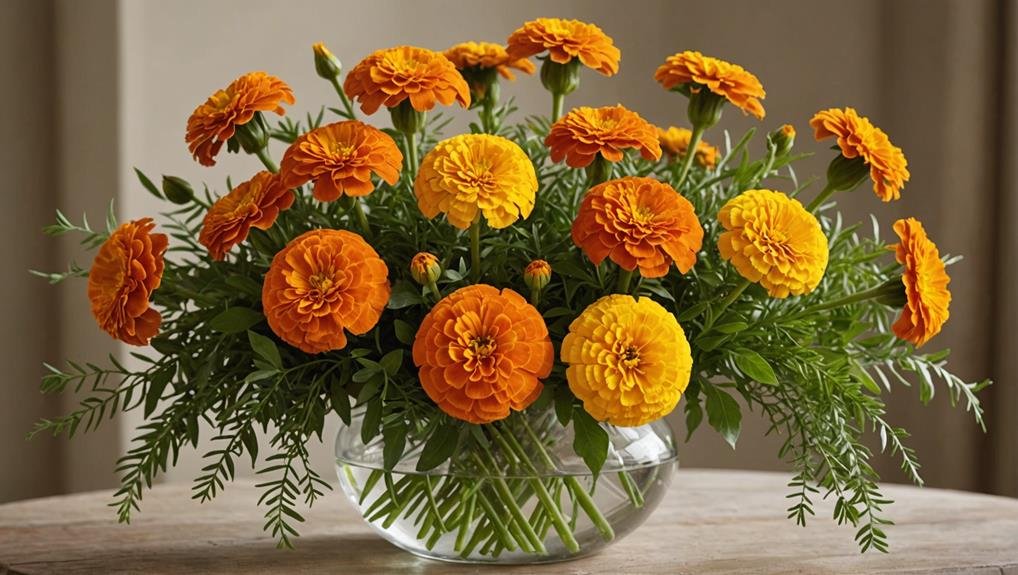
Marigolds are a diverse group of flowers, including types such as French, African, and Signet, each distinguished by unique colors, structures, and aromas. The vibrant colors of marigolds range from bright yellows and oranges to deep reds, offering a wide variety of options to enhance any wedding setting.
Renowned for their unique charm and robust nature, marigolds bring a rustic yet elegant touch to floral arrangements, making them a favored choice for wedding bouquets and decorations.
The beauty of marigolds lies not only in their vibrant colors but also in their symbolic meanings. They are often associated with positivity, prosperity, and durability, which resonates well with the themes of love and commitment celebrated at weddings.
Their robust nature ensures that they thrive in warmer climates, peaking in late spring, summer, and early autumn, thereby providing a reliable and attractive floral option during these seasons.
Selecting the right type and color of marigold can greatly enhance the visual appeal and mood of a wedding, complementing various themes and seasonal settings. Whether opting for the elegance of African marigolds or the delicate charm of Signet varieties, marigolds offer versatile beauty for any matrimonial celebration.
Physical Description
Featuring dense clusters of petals, these vibrant flowers display hues of yellow, orange, and red, creating a full, round bloom. Marigolds, or Tagetes patula, are renowned for their striking appearance, making them a popular choice in flower arrangements. The bright yellow and varied shades of orange and red are characteristic of marigolds, enhancing their visual appeal.
Marigolds come in a variety of colors and sizes, ranging from small, dainty blooms to larger, more showy flowers. This versatility allows them to be used effectively in diverse floral settings, from intimate bouquets to grandiose centerpieces. The structure of the petals is usually dense and layered, giving the flowers a plush, textured look.
The leaves of marigold plants are typically dark green and finely divided, providing a beautiful contrast to the vivid flowers. This foliage adds an extra layer of depth and interest to floral arrangements. Additionally, some marigold varieties emit a distinct spicy or musky fragrance, adding an olfactory layer to their physical allure.
Available Colour Varieties
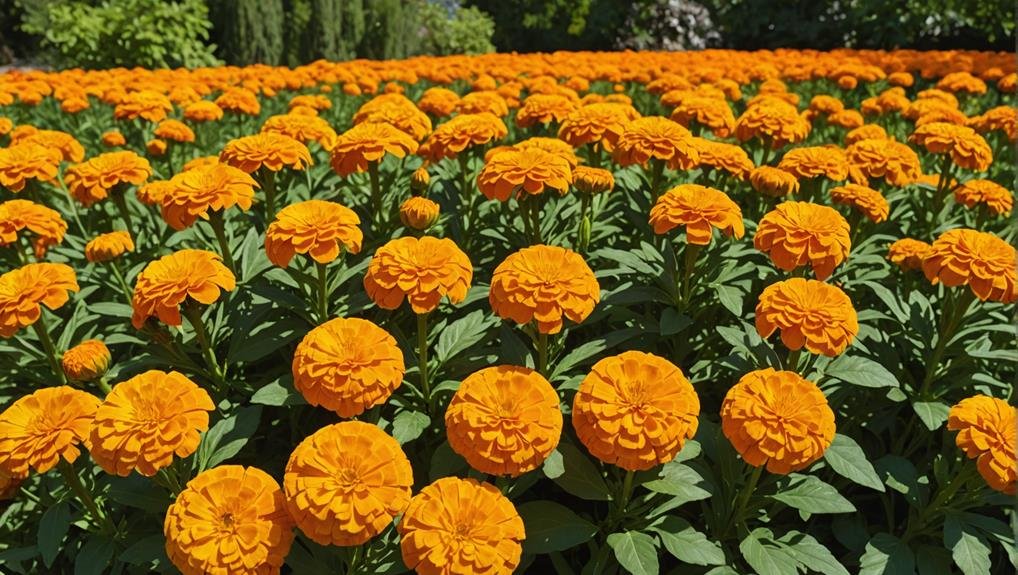
When considering the available colour varieties, one finds that marigolds offer a stunning array of vibrant shades, from radiant yellows to deep, rich reds. These hues of marigolds can elegantly enhance any wedding bouquet or floral arrangement, making them a versatile choice for various themes and styles.
French Marigolds are particularly noted for their diverse palette, including shades of lemon, tangerine, and classic orange. These vibrant hues can be further complemented by the bi-color blooms that some French Marigold varieties present, such as yellow with red tips or orange with gold centers. This characteristic adds a dynamic visual interest to floral displays.
African Marigolds, on the other hand, are celebrated for their robust and deep oranges and gold tones, which can bring warmth and a sense of richness to wedding decorations. These varieties often feature larger blooms, making them ideal for statement pieces.
Signet Marigolds offer unique and elegant shades, including lemon gem, tangerine gem, and golden gem. These colors are particularly effective in creating sophisticated and refined floral arrangements.
The diverse color palette of marigolds not only allows for creative combinations but also guarantees that every wedding can have its own unique and stunning floral display.
Latin Name and Taxonomy
The genus Tagetes, encompassing the well-loved marigold, derives its name from the Etruscan deity Tages, reflecting the plant’s historical and cultural significance. Marigolds, known for their vibrant hues, belong to the Asteraceae family, a diverse group that also includes sunflowers, daisies, and asters. This family is celebrated for its array of colorful and structurally intricate flowers, which have captivated both gardeners and florists alike.
Within the genus Tagetes, there are several notable species, with Tagetes erecta, commonly known as the African marigold, and Tagetes patula, known as the French marigold, being the most prominent. The taxonomy of marigolds places them firmly within the order Asterales, highlighting their evolutionary relationships with other well-known flowering plants. This classification underscores the botanical characteristics that define marigolds, such as their composite flower heads and prolific blooming patterns.
Understanding the Latin name and taxonomy of marigolds not only enhances our appreciation of their botanical lineage but also aids in the selection and cultivation of these flowers for various uses, including wedding arrangements. This taxonomy provides a framework for exploring their diverse species and their adaptability to different environments.
Geographical Origins
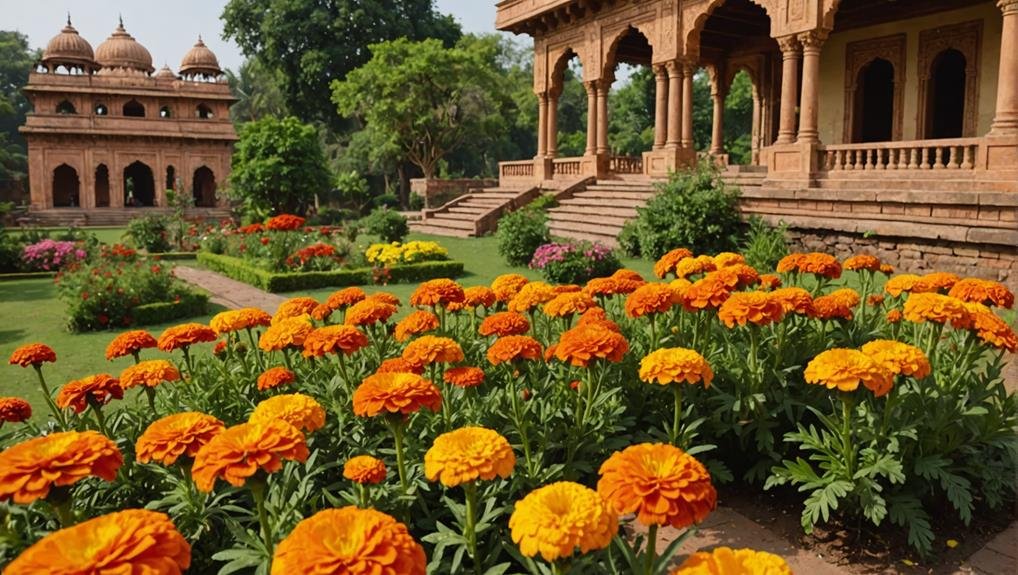
Originating in the Americas, marigolds were first cultivated by the Aztecs in regions that now comprise Mexico and Central America. These vibrant flowers, known for their striking colors and hardy nature, thrived in the warm climates typical of these regions.
The Aztecs utilized marigolds extensively, appreciating their versatility for medicinal, ceremonial, and decorative purposes. Their profound cultural significance was evident in various rituals and traditions, where marigolds symbolized the vibrant life and connection to the divine.
As marigolds spread globally, they became a beloved addition to gardens and ceremonies in Europe, Asia, and Africa. However, their deep roots remain in the warm climates of Mexico and Central America, where their historical and cultural significance continues to be celebrated.
The marigold’s ability to flourish in diverse environments made it a popular choice for gardeners and florists worldwide. Their resilience and adaptability further underscore their importance in various cultural contexts. Whether adorning temples, homes, or wedding venues, marigolds stand as a testimony to their enduring appeal and historical prominence.
The marigold’s journey from the ancient Aztec gardens to contemporary celebrations highlights its enduring significance and versatility.
Season Availability
Marigolds, celebrated for their historical significance and vibrant presence, are most abundant during late spring, summer, and early autumn. Their season availability makes them an ideal choice for weddings occurring during these times. In the United States, Marigolds typically bloom from late spring to early fall, with their peak abundance observed in midsummer. This period guarantees access to the freshest blooms for your special day.
Opting for Marigolds during their natural growing season not only secures vibrant and fresh blooms but also aligns with their inherent durability. Marigolds are known to withstand various weather conditions, adding a resilient charm to any wedding bouquet. Their ability to thrive in warmer climates further emphasizes their suitability for summer weddings.
The following table outlines the seasonal availability of Marigolds:
| Season | Availability | Peak Abundance |
|---|---|---|
| Late Spring | High | Moderate |
| Early Summer | Very High | High |
| Midsummer | Very High | Peak |
| Late Summer | High | Moderate |
| Early Autumn | Moderate | Low |
Incorporating Marigolds into your wedding arrangements during these seasons secures that their vibrant hues and fresh blooms add a touch of seasonal elegance to your celebration.
Growing Conditions
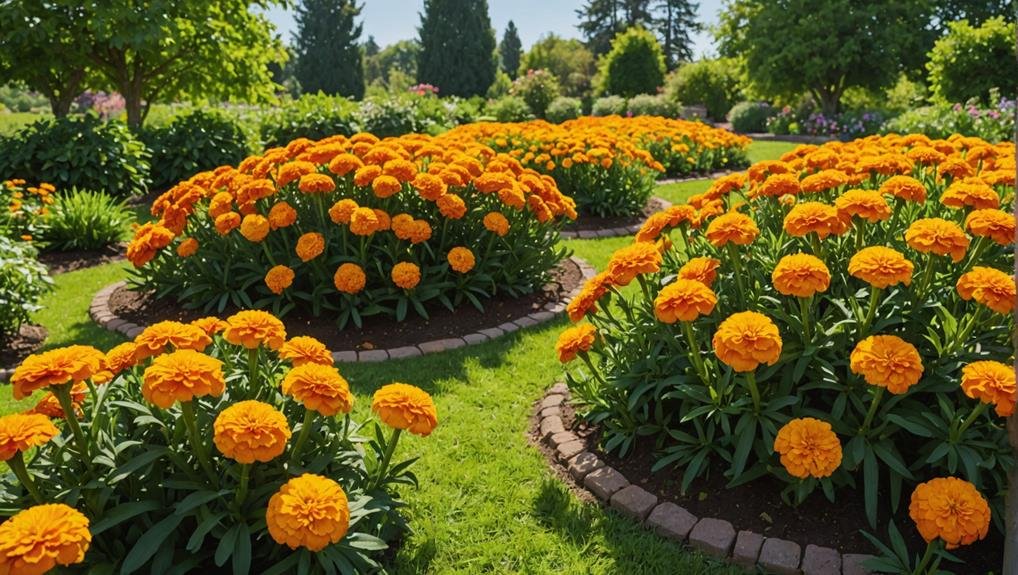
To cultivate marigolds successfully, make certain they receive a minimum of 6 hours of direct sunlight daily. These vibrant flowers thrive in full sun, which is crucial for their growth and blooming.
Additionally, marigolds prefer well-drained soil, as excessive moisture can lead to root rot and other issues. Ensuring the soil has moderate moisture levels will help in fostering a healthy root system.
Marigolds are known for being drought-tolerant, making them an excellent choice for gardens in hot and arid conditions. These annual plants complete their life cycle within one growing season, allowing for seasonal flexibility in garden planning.
For best growth, consider the following key points:
- USDA Hardiness Zones: Marigolds grow best in USDA hardiness zones 2-11, offering a wide range of suitable climates.
- Soil Conditions: Guarantee the soil is well-drained to prevent waterlogging, which can be harmful to marigolds.
- Sunlight Requirements: Provide at least 6 hours of direct sunlight daily to support strong growth and vibrant blooms.
Cultural Significance
Beyond their adaptability and easy cultivation, marigolds hold profound cultural significance in various traditions around the world. In Indian weddings, marigolds are emblematic of auspiciousness, happiness, and prosperity. Their vibrant hues and robust fragrance make them indispensable in ceremonies, where they adorn venues and form intricate garlands, symbolizing the sanctity and joy of the occasion.
In Mexico, marigolds play a pivotal role in Dia de los Muertos (Day of the Dead) celebrations. Known as ‘cempasúchil,’ these flowers are believed to guide the spirits of deceased loved ones back to the living world. The bright orange and yellow petals are used to create elaborate altars, infusing the atmosphere with a sense of reverence and remembrance.
Hindu traditions also revere marigolds as sacred flowers. Garlands made from marigolds are frequently offered to deities during religious ceremonies and festivals, symbolizing devotion and purity. Their presence in temples and homes underscores their spiritual significance.
Historically, the Aztec civilization considered marigolds sacred flowers, dedicating them to the sun god and incorporating them into various rituals and ceremonies. This rich tapestry of cultural significance highlights the marigold’s enduring appeal across different societies and epochs.
Typical Use in Weddings
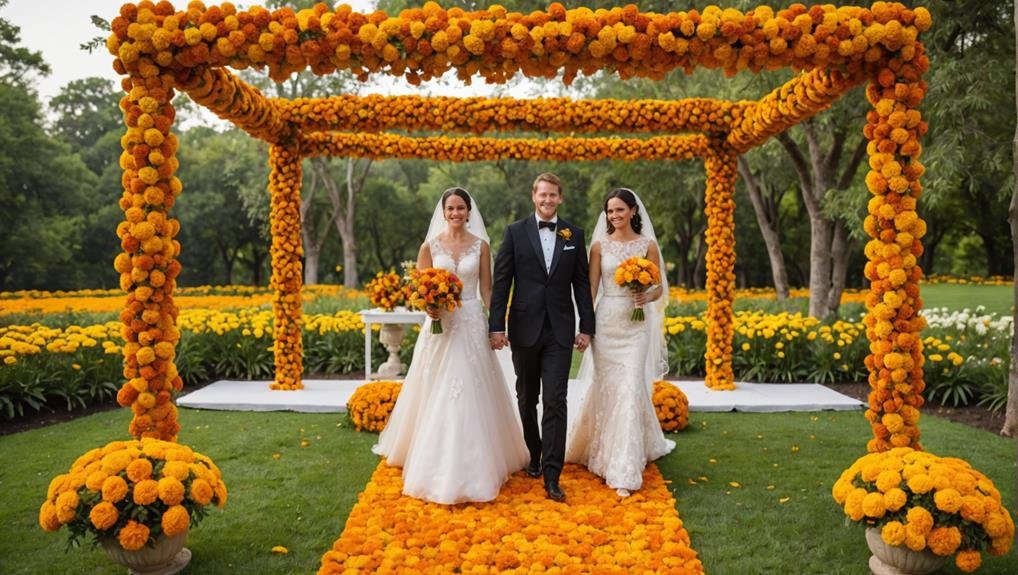
In wedding ceremonies, marigolds are frequently incorporated into various floral arrangements, including bouquets, centerpieces, garlands, and decorative installations. Their vibrant colors and unique textures add a pop of color and rustic charm to wedding decor, making them a popular choice for couples looking for a lively and festive atmosphere.
Marigolds symbolize positivity, prosperity, and durability, attributes that align well with the sentiments of a wedding ceremony. These distinctive flowers are versatile and can complement a range of wedding themes and color schemes, from traditional and rustic to modern and elegant. Additionally, marigolds are a budget-friendly option, offering a cost-effective yet visually striking floral choice for couples mindful of their wedding expenses.
Here are three common ways marigolds are used in wedding settings:
- Bouquets: Marigolds are often used in bridal and bridesmaid bouquets, either as the main flower or as a vibrant accent to other blooms.
- Centerpieces: These flowers are frequently used in table centerpieces, adding a warm and inviting touch to the reception decor.
- Garlands: Marigold garlands are popular for decorating ceremony arches, entranceways, and even as wearable floral accessories.
Alternative Flower Types
Several different flower varieties, such as dahlias, zinnias, and gerbera daisies, can complement or substitute marigolds in wedding arrangements, offering a variety of colors and textures to enhance the overall aesthetic.
Dahlias are particularly versatile, available in an extensive range of colors and shapes. This diversity allows them to be seamlessly incorporated into wedding bouquets and centerpieces, adding depth and visual interest.
Zinnias, recognized for their vibrant shades and long vase life, make an excellent choice for wedding decorations. Their durability guarantees that arrangements remain fresh and lively throughout the event, providing a practical yet beautiful option for couples seeking reliable floral elements.
Gerbera daisies, symbolizing innocence and purity, bring a charming and elegant touch to wedding floral designs. Their large, striking blooms can stand alone or be mixed with other flowers to create captivating arrangements that exude a sense of sophistication.
Incorporating different flower types like dahlias, zinnias, and gerbera daisies with marigolds can result in unique and visually stunning wedding arrangements. This blend of florals offers not only aesthetic appeal but also a diverse range of textures and colors, enhancing the overall atmosphere of the celebration.
